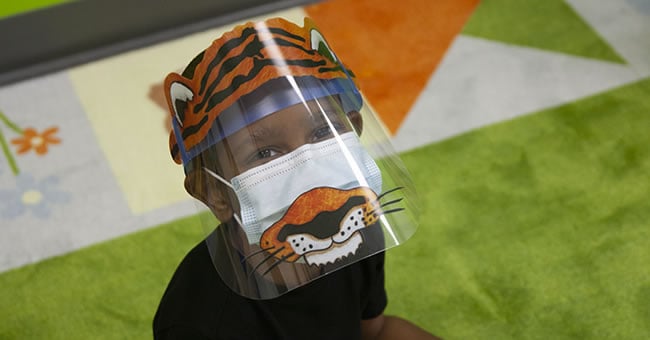
In this blog, Dr. Angela Searcy provides easy activity ideas for caregivers and educators looking for ways to make wearing masks in the classroom less scary for young children.
In many places, masks or face coverings are being used to limit the spread of COVID-19. If a child is over the age of two, can take off a mask independently, and doesn't have trouble breathing, they might be wearing a face covering in classroom environments. While other children might only see grownups around them wearing masks without wearing one themselves, no matter what the circumstances are these activities are designed to make masks fun and less scary for young children.
Introduce young children to wearing face masks with these easy activities using puppets or other classroom props:
- Cut card stock or paper plates in half and make mouths of different shapes to show different feelings like happy, surprised, sad, confused, and angry. Encourage children to use these props to show different emotions. Model how to use props with a puppet friend.
- Learning Objectives: literacy, language, art, social emotional
- Use math skills to graph all the different types and colors of face coverings in your classroom on flip chart paper. Share your data (take a photo or share flip chart paper) and use analysis skills to compare it to a different classroom. Expand the lesson by comparing similarities and differences between rooms.
- Learning Objectives: math and science
- Use puppets to talk about the proper way to wash face coverings. Next, have children pretend to wash face coverings they've created on their own in individual "water bins." Encourage children to use fine motor skills to hang up their clean face coverings on a clothesline to dry. Children can use critical thinking and analysis skills to predict how long it will take the masks to dry.
- Learning Objectives: science and fine motor skills
- Take photos of the children or staff showing a smile without a face covering. Create buttons, t-shirts, or signs using these photos so everyone can remember what their teachers and classmate's face looks like without masks. This can be helpful for babies because even though they are not wearing masks, their caregivers are.
- Learning Objectives: social and emotional
The CDC recommends adults teach and reinforce children using masks, but there is no need for harsh discipline or punishment. The CDC recognizes that young children will need support and frequent reminders to wear face coverings properly. Tell parents that wearing face coverings is encouraged and, if needed, students can take short breaks if they are feeling overwhelmed.
Positively reinforce wearing masks in the classroom with these activities:
- Designate a calming and mindful space in your classroom for socially distanced mask breaks. Create a sign-up sheet for children to "sign up" to take a mask break. Support early writing skills and incorporate lessons on time by encouraging children to write their own names and use a sand timer to keep track of their mask break (2 minutes).
- Sing a song! Music lights up the brain more than any other human interaction. But, because COVID-19 spreads from person to person through droplets in the air, activities like singing as a group can produce these types of droplets and should be avoided. However, teachers can still pre-record themselves singing and play that recording for children. Playing a recorded song to children is a fun way to remind children to wear a mask.
- Create a Mask 'O Meter to track and celebrate how children are learning to wear masks for longer periods of time. Keep in mind A Mask 'O Meter is a way to notice positive skills, it is not used to point out if a child forgot to wear a mask.
- Reminder: It may seem like a good idea to show children that you are angry or sad when they don't wear their mask. Instead, it is recommended to respond with "How can I help you?" and give friendly reminders to wear a mask using a visual or a fun song.
Please keep in mind that masks or face coverings are not a substitute for social distancing and are encouraged when social distancing is hard to maintain.
About the Author
An educator since 1990, Dr. Angela Searcy has experience at all levels of education providing services to children and families as a teacher, child-development specialist, and independent consultant. A former neurodevelopment specialist, she is the owner and founder of Simple Solutions Educational Services, a professional-development company. She is a trainer, a speaker, and an adjunct instructor and seminar leader at the Erikson Institute in Chicago, Illinois.
Explore More From This Author
Comforting Children While Following CDC Guidelines
Talking to Children About Racism
